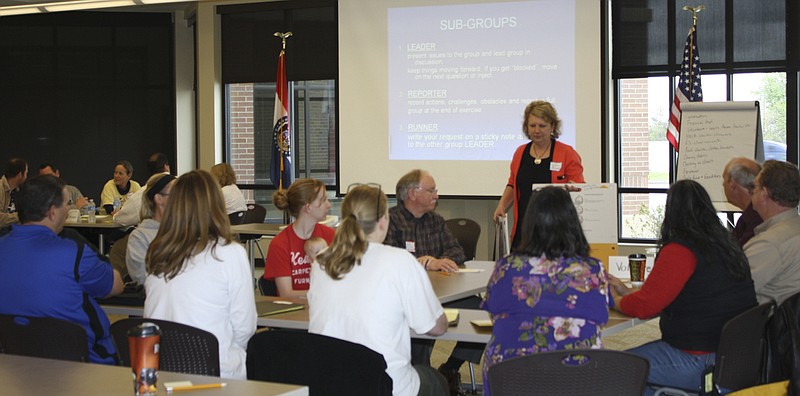About 50 representatives of local government agencies and volunteer organizations met Tuesday in Fulton to discuss how to coordinate social services after a major natural disaster.
Lisa Binkley, mass care coordinator for the Region F Homeland Security Oversight Committee, told the group that the meeting is designed to help deal with a disaster aftermath that leads to homelessness and medical needs of survivors.
Each of the representatives told the group the services that they would be able to provide during and after a disaster. They then discussed how to coordinate all of the volunteer efforts with existing government services.
Michelle Kidwell, director of Callaway County Emergency Management, said the biggest natural disaster need for coordinated services by volunteers would come in the aftermath of a devastating tornado, flood, ice storm or earthquake.
"During a disaster, the Callaway County Emergency Operations Center will be working with first responders for fire, law enforcement and medical needs. They are the ones dealing directly with the disaster," Kidwell said. "What we are doing today is trying to build another tier of support from social networks and show them how they can help by working together to provide coordinated services that will still be needed after the immediate disaster is dealt with."
"After the first responders have put out the fire and have things secured," Binkley said, "there are many needs in the community that must be met for recovery. Every family has its own set of needs based on the resources they have. But sometimes those resources can be exhausted by working through only one agency.
"By bringing together a coordinated community effort, resources can be shared. The needs of clients can be assessed and a way figured out to meet those needs, perhaps through another agency."
Binkley said the recovery phase after a disaster may last months or years, depending on the severity of the disaster.
A coordinated local disaster plan was formed after the ice storm in 2006. The Callaway County organization, known as the Community Organizations Active in Disaster (COAD), is headed by Pam Phelps.
COAD includes community organizations that offer aid to meet local human service needs. They include governmental, non-profit, volunteer, faith-based, public service organizations and businesses.
COAD functions within the Callaway County Emergency Operations. It helps with shelter operations, volunteer management, donation management, unmet community needs and coordinating support from other communities outside the county.
Callaway County Western District Commissioner Doc Kritzer reminded members of the emergency responder group that they also should have an emergency plan for their own family to make sure the needs of their spouses and children are met, because they are likely to be pressed into service for long periods of time.
"A bag needs to be packed with a change of clothes because you need to be available to assist in the overall effort to deal with a disaster," Kritzer said. "It may be a couple of days before you get back home. Make sure you also have an emergency plan for your own family."
Eastern District Commissioner Gabe Craighead said county road and bridge crews after a tornado are likely to be busy clearing trees from roads.
Kathy Richey-Liddle, director of the Callaway County United Way, explained that by dialing 211, the statewide helpline, the call goes to a database in St. Louis that includes a listing of various local services. The coordinator answering the phone should be able to link an individual's needs with an appropriate service or volunteer agency in Callaway County.
The 211 statewide helpline provides social services the same way that 911 provides emergency services. People also can dial 211 and offer their unique services to help their neighbors as a volunteer.
Matt Harline, assistant to the Fulton director of administration, said city utility crews will be working on restoring or maintaining city utility services. Police and fire departments will be assisting with search and rescue work in the aftermath of the disaster. He said the city has some natural gas- and diesel-powered generators that can generate electricity to power some water and electrical needs.
Government agencies and social service volunteer organizations represented at the planning meeting included Callaway Community Hospital, American Red Cross, Callaway Amateur Radio, Southside Baptist Church, Callaway Emergency Communications, Callaway County Commission, Fulton Public Schools, Callaway County Water District No. 2, University Extension, United Way, Callaway County Health Department, City of Fulton, Callaway County Special Services, Callaway County Emergency Management Agency, First Assembly of God Church, 4-H Clubs, Callaway County Community Organizations Active in Disaster (COAD), SunCrest Home Health, Callaway County Humane Society, and Homemaker Health Care.

